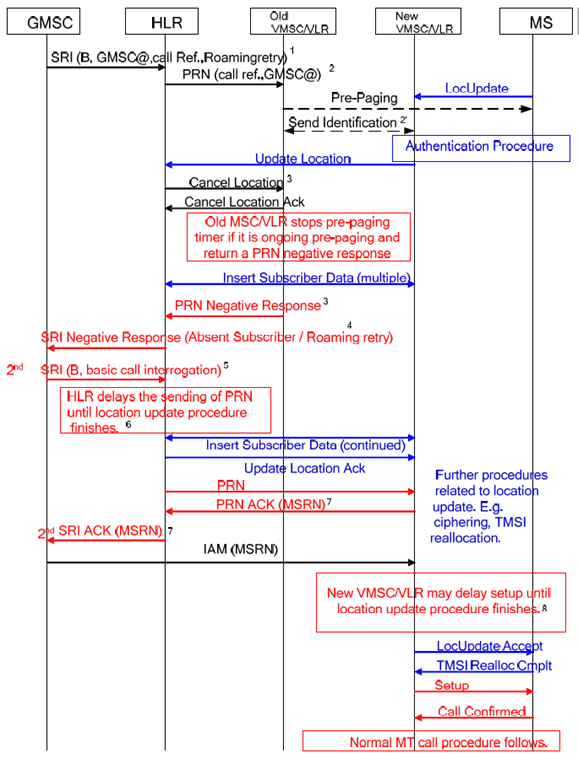Content for TS 23.018 Word version: 18.0.0
5.2.2 Mobile Terminating Roaming Retry Call during Retrieval of Routeing Information |R9| p. 20
The information flow for mobile terminating roaming retry call during retrieval of routing information is shown in Figure 4b. It applies to a mobile terminating call while the called mobile is simultaneously moving from an old to a new MSC, if the GMSC and the HLR support the MT Roaming Retry procedure. The procedure may e.g. apply during pre-paging if the GMSC, HLR and old MSC/VLR support pre-paging.
In that case, upon receipt of:
- a MAP Cancel Location procedure while on-going pre-paging,

Figure 4b: Information flow for a mobile terminating roaming retry call during Retrieval of Routeing Information
(⇒ copy of original 3GPP image)
(⇒ copy of original 3GPP image)
Step 1.
A GMSC supporting the "mobile terminating roaming retry" feature includes the Call Reference Number, the GMSC address, and the MT Roaming Retry Supported IE in the first SRI sent to the HLR. The Pre-paging Supported IE is included in the SRI message if the GSMC supports the "Pre-paging" feature.
Step 2.
A HLR supporting the "mobile terminating roaming retry" feature includes the Call Reference Number and the GMSC address in the PRN sent to the MSC/VLR if received in the SRI. If GMSC and HLR support the "Pre-paging" feature, the Pre-paging Supported IE is included in the PRN message.
Step 2'.
An old VLR supporting the "mobile terminating roaming retry" feature may indicate in the MAP Send Identification response sent to the new VLR whether there is a pending mobile terminating call at the old VLR.
Step 3.
Upon receipt of the MAP Cancel Location message while pre-paging, the old MSC/VLR stops pre-paging and sends a PRN negative response message to the HLR. If meanwhile the HLR has received a new Update Location procedure from a new MSC/VLR, the HLR returns a SRI negative response with error "absent subscriber" including the reason "mtRoamingRetry" to the GMSC.
Step 4.
Upon receipt of the SRI negative response with error "absent subscriber" including the reason "mtRoamingRetry", the GMSC re-sends a new SRI to the HLR (still a 'basic call' interrogation type) using a new call reference number.
Step 5.-8.
See the same procedures from step 5 to step 8 in the Figure 4a.
Similarly, a HLR supporting the "mobile terminating roaming retry" feature should wait for the completion of any on-going Location Update procedure when processing other terminating requests e.g. MAP-SEND-ROUTING-INFO-FOR-SM, MAP-SEND-ROUTING-INFO-FOR-LCS, MAP-ANY-TIME-INTERROGATION. More generally, this also applies to all TCAP transactions that the HLR may have to open toward a VLR (e.g. USSD, PSI).